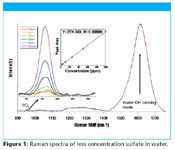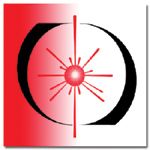Article
Application Notebook
Application Notebook
Raman Analysis of Low Concentration Ions in Water
Author(s):
High sensitivity Raman analyzers could provide solutions for continuous and automated measurements of low concentration ions or molecules in aqueous solutions for applications in industries including biomedical, mining, agrichemical, pharmaceutical, cleaning, and environmental. As an example for similar applications, the quantitative analysis of low concentration sulfate ion in aqueous solution down to as low as 2.5 ppm by conventional (Non-SERS) Raman is demonstrated.
Enwave Optronics
High sensitivity Raman analyzers could provide solutions for continuous and automated measurements of low concentration ions or molecules in aqueous solutions for applications in industries including biomedical, mining, agrichemical, pharmaceutical, cleaning, and environmental. As an example for similar applications, the quantitative analysis of low concentration sulfate ion in aqueous solution down to as low as 2.5 ppm by conventional (Non-SERS) Raman is demonstrated.
Experiment
Solutions of sulfate with concentration below 100 ppm were prepared by dissolving sodium sulfate in distilled water. One ppm is defined as one milligram of SO4 in one liter of water. An Enwave ProRaman instrument with a wavelength-stabilized 785 nm laser, a high throughout TEC-controlled CCD spectrograph, and a fiber optics probe was used for the measurements. All solutions were kept in quartz cuvette during the measurements.
Results and Discussion
Figure 1 shows the v1 (SO42– ) Raman peaks at ~980 cm–1 for sulfate aqueous solutions with concentrations of 2.5, 5, 10, 25, 50, and 100 ppm. The spectra are backgrounds corrected. Notably the water O-H bending mode at around 1640 cm–1 is very strong compare to the sulfate v1 peak in these solutions. The close-up view of the sulfate v1 peak with increasing concentration from 2.5 to 100 ppm is shown in the inset. The second inset shows the areas of the sulfate v1 peak scaled linearly with the concentration. The fitting parameter R2 ~0.99986 indicates a very good correspondence in the instrument readings and the concentrations of the prepared solutions.

Figure 1
Conclusion
Quantitative determinations of sulfate ion concentrations down to as low as 2.5 ppm in aqueous solutions were conducted by using a high-sensitivity Raman spectrometer. Aqueous solutions of ions like nitrate, phosphate, carbonate, sulfite, nitrite, silicate, bicarbonate, and ammonium, etc, could also be analyzed to similar or lower concentrations. Quantitative analyses of these ionic species along with other molecular species to similar concentration level are important in many industrial applications.
The developments of SERS techniques in recent years gave hopes for measurements of low concentration aqueous samples with Raman spectrometers. Nevertheless, difficulties exist in the requirements of robust, continuous, and automated measurements in various industrial settings. This application note shows the possibility of analyzing low concentration ionic species in water with a state of the art conventional dispersive Raman instrument. For even lower concentration measurements, different configurations of Raman instrument, e.g. using shorter wavelengths excitation lasers, could also be devised to meet the sensitivity requirements.

Enwave Optronics
18200 McDurmott St., Suite B, Irvine, CA 92614
Tel. (949) 955-0258, Fax (949) 955-0259
Website: www.enwaveopt.com

Newsletter
Get essential updates on the latest spectroscopy technologies, regulatory standards, and best practices—subscribe today to Spectroscopy.